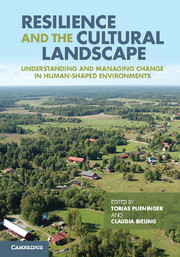 Resilience and the Cultural Landscape
Resilience and the Cultural Landscape Published online by Cambridge University Press: 05 November 2012
Introduction
An important challenge in the quest for sustainable development is to understand and manage changes in the physical landscape. It is widely acknowledged that this has to be achieved within a multidimensional framework where human well-being, species, biodiversity and many other values are recognised (MA, 2005). In order to enhance social and ecological responsible governing, analytical tools are needed that can identify potentially problematic trends as well as contribute to the formulation of effective management strategies. In this context the importance of national and global perspectives is indisputable – but not sufficient. If one includes material and immaterial features and processes, and considers the unique constellations of these at different sites, strategies for sustainable development must, by necessity, reflect local variation. This is even more apparent as drivers of land use change operate at various spatial, temporal and institutional scales, and also with their influence differing depending on local socioeconomic and biophysical characteristics (further developed by Bürgi et al., Chapter 7; Eiter & Potthoff, 2007). Therefore, the success of managing change will, to a large extent, depend on considerations made by local authorities in their comprehensive planning for specific areas, as expressed in the Rio Declaration on Environment and Development. This calls for a qualified understanding of the integrated relationship between social and ecological aspects also from a more narrow scale perspective.
‘Social–ecological systems’ is a concept used to frame an integrated perspective that links human society and nature commonly applied within resilience thinking (or resilience theory). Although it has become widely used since its introduction in the 1990s, the concept is still considered to be in an exploratory phase, where one of the key challenges is to come to grips with complexity (Cumming, 2011; Ostrom, 2009). The concept departs from an explicit system approach, where concepts are characteristically generated mainly from theory, and interrelationships are based on extrapolations and generalisations, rather than on vicinity and physical affinity (Törnqvist, 1981). However, studies employing the concept of social–ecological systems often relate to specific case studies, that is, investigations of specific areas of a limited size (Berkes & Folke, 1998; Berkes et al., 2003), and the concept thereby assumes a spatial definition. In this way, social–ecological systems show apparent overlaps with conceptualisations of landscape, most notably with the spatial landscape perspective within geography (Olwig, 2007).
To save this book to your Kindle, first ensure [email protected] is added to your Approved Personal Document E-mail List under your Personal Document Settings on the Manage Your Content and Devices page of your Amazon account. Then enter the ‘name’ part of your Kindle email address below. Find out more about saving to your Kindle.
Note you can select to save to either the @free.kindle.com or @kindle.com variations. ‘@free.kindle.com’ emails are free but can only be saved to your device when it is connected to wi-fi. ‘@kindle.com’ emails can be delivered even when you are not connected to wi-fi, but note that service fees apply.
Find out more about the Kindle Personal Document Service.
To save content items to your account, please confirm that you agree to abide by our usage policies. If this is the first time you use this feature, you will be asked to authorise Cambridge Core to connect with your account. Find out more about saving content to Dropbox.
To save content items to your account, please confirm that you agree to abide by our usage policies. If this is the first time you use this feature, you will be asked to authorise Cambridge Core to connect with your account. Find out more about saving content to Google Drive.